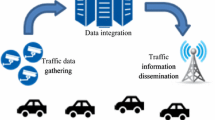Abstract
A behavior-consistent information-based network control approach determines real-time traffic routing strategies by explicitly accounting for drivers’ likely response to the controller-recommended routes while generating these strategies. This paper proposes paradigms to deploy a behavior-consistent approach developed by the authors (Paz and Peeta 2007). These paradigms seek to enhance deployment effectiveness by analyzing the effects of alternative controller objectives and driver-preferred route sets used to recommend routes. Experiments are conducted using a test network. They analyze: (1) the performance of the behavior-consistent approach under commonly-used controller objectives, (2) the deployment flexibility enabled by increasing the number of driver-preferred routes considered by the controller for routing, and (3) the effects of augmenting the driver-preferred route choice set through various paradigms. The results suggest that the behavior-consistent approach can perform better than standard dynamic traffic assignment models while directing the system towards the desired state. They also illustrate the effectiveness of considering more driver-preferred routes in developing the information strategies. Further, they suggest that driver-preferred route choice set augmentation and the associated route types can have differential impacts on performance. Also, performance is influenced by trade-offs between the number of driver-preferred routes considered by the controller for routing and the quality of routes relative to the controller objective. The results suggest that higher compliance rates may not translate to better performance and question the justification of user equilibrium solutions for route guidance on the ground that a system optimal strategy is not behaviorally sustainable.












Similar content being viewed by others
References
Bekhor S, Ben-Akiva ME, Ramming MS (2006) Evaluation of choice set generation algorithms for route choice models. An Oper Res 154(1):245–257
Ben-Akiva ME, Bierlaire M (1999) Discrete choice methods and their applications to short-term travel decisions. In: Hall RW (ed) Handbook of transportation science. Kluwer Academic, Boston
Ben-Akiva ME, Bierlaire M, Bottom J, Koutsopoulos HN, Mishalani RG (1997) Development of a route guidance generation system for real-time application. In: Papageorgiou M, Pouliezos A (eds) Proc of the 8th IFAC Sympos on Transpo Sys. Elsevier Science, Oxford, UK
Bonsall PW, Joint M (1991) Evidence on drivers' reaction to in-vehicle route guidance advice. Proc of the 24th Int. Sym. on Automotive Technology and Automation, Florence, Italy
Chiu Y-C (2002) Generalized real-time route guidance strategies in urban networks. Ph.D. Thesis, Department of Civil and Environmental Engineering, University of Texas, Austin
Hall RW (1996) Route choice and advanced traveler information systems on a capacitated and dynamic network. Transpo Res C Emerg Tech 4(5):289–306
Jahn O, Möhring RH, Schulz AS, Stier-Moses NE (2005) System-optimal routing of traffic flows with user constraints in network with congestion. Ann Oper Res 53(4):600–616 doi:10.1287/opre.1040.0197
Mahmassani HS (2001) Dynamic network traffic assignment and simulation methodology for advanced system management applications. Network Spatial Econ 1(3/4):267–292 doi:10.1023/A:1012831808926
Mahmassani HS, Hu T-Y, Peeta S, Ziliaskopoulos A (1994) Development and testing of dynamic traffic assignment and simulation procedures for ATIS/ATMS applications. Technical report DTFH61-90-R-0074-FG, Center for Transportation Research, University of Texas, Austin
Nakayama S, Kitamura R (2000) Route choice model with inductive learning. Transp Res Rec 1725, TRB, National Research Council, Washington, D.C:63–70
Paz A, Peeta S (2007) Network-level evaluation of real-time behavior-consistent traffic routing strategies. In: Proc of the 86th Annual Meeting of the Transp Res Board, Washington, DC.
Paz A, Peeta, S (2008a) Information-based network control strategies consistent with estimated driver behavior. Transportation Research Part B: Methodological. doi:10.1016/j.trb.2008.06.007
Paz A, Peeta S (2008b) On-line calibration of behavior parameters for behavior-consistent route guidance. Transportation Research Part B: Methodological. doi:10.1016/j.trb.2008.07.007
Peeta S, Ziliaskopoulos A (2001) Foundations of dynamic traffic assignment: the past, the present and the future. Network Spatial Econ 1(3/4):233–266 doi:10.1023/A:1012827724856
Peeta S, Yu JW (2005) A hybrid model for driver route choices incorporating en-route attributes and real-time information effects. Network Spatial Econ 5(1):21–40 doi:10.1007/s11067-005-6660-9
Peeta S, Yu JW (2006) Behavior-based consistency-seeking models as deployment alternatives to dynamic traffic assignment models. Transpo Res C Emerg Tech 14(2):114–138
Ramming MS (2002) Network knowledge and route choice. Ph.D. Thesis, Department of Civil and Environmental Engineering, MIT, Boston
Stier-Moses NE (2004) Selfish versus coordinated routing in network games. Ph.D. Thesis, Sloan School of Management, MIT, Boston
Vaughn KM, Abdel-Aty MA, Kitamura R, Jovanis PP, Yang H (1993) Experimenting analysis and modeling of sequential route choice under ATIS in a simple traffic network. PATH Research Report 93–12
Author information
Authors and Affiliations
Corresponding author
Rights and permissions
About this article
Cite this article
Paz, A., Peeta, S. Paradigms to Deploy a Behavior-Consistent Approach for Information-Based Real-Time Traffic Routing. Netw Spat Econ 9, 217–241 (2009). https://doi.org/10.1007/s11067-008-9077-4
Published:
Issue Date:
DOI: https://doi.org/10.1007/s11067-008-9077-4




